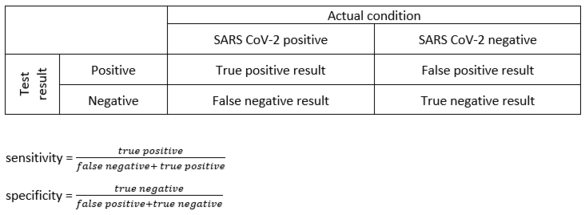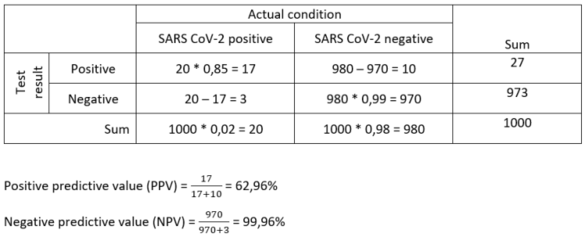Explanations
Sensitivity and specificity are often perceived as rather abstract terms. In the following passages we will explain these terms and other important terminology in more detail and also illustrate them by example for further clarification. In addition, following this link, you will find a tool to determine the false positive and false negative findings, as well as the positive and negative predictive values.
The percentage of SARS-CoV-2 infected persons within a certain group of people is termed incidence. For example, a SARS CoV-2 incidence of 2% for a city with 1000 inhabitants translates into 20 citizens being positive for SARS CoV-2.
The sensitivity and specificity of a test reflect how reliably the test can determine whether a person is positive or negative for SARS CoV-2.
The sensitivity only refers to the group of people that are indeed positive for SARS CoV-2. It indicates which proportion of SARS CoV-2 positive individuals is being identified as positive by the test (true positive result) and how many people are falsely identified as not infected with SARS-Cov-2 (false negative result).
By contrast, specificity is based solely on the number of people that are not infected with SARS CoV-2. It indicates which proportion of SARS-CoV-2 negative individuals is being identified as negative by the test (true negative result) and how many people are falsely identified as infected (false positive result).
This results in the following matrix:

In addition, the so-called positive or negative predictive value of a test is often given.
In contrast to sensitivity and specificity, the predictive value does not define the proportion of people correctly diagnosed by a test. The predictive value rather determines the probability that a positive or negative test result corresponds to the actual condition.

The following example is intended to further illustrate the terminology.
We again consider a city with 1000 inhabitants and a SARS CoV-2 incidence of 2%. An exemplary test has a sensitivity of 85% and a specificity of 99%.

Following this link, you will find a tool to calculate false positive and false negative findings as well as positive and negative predictive values.